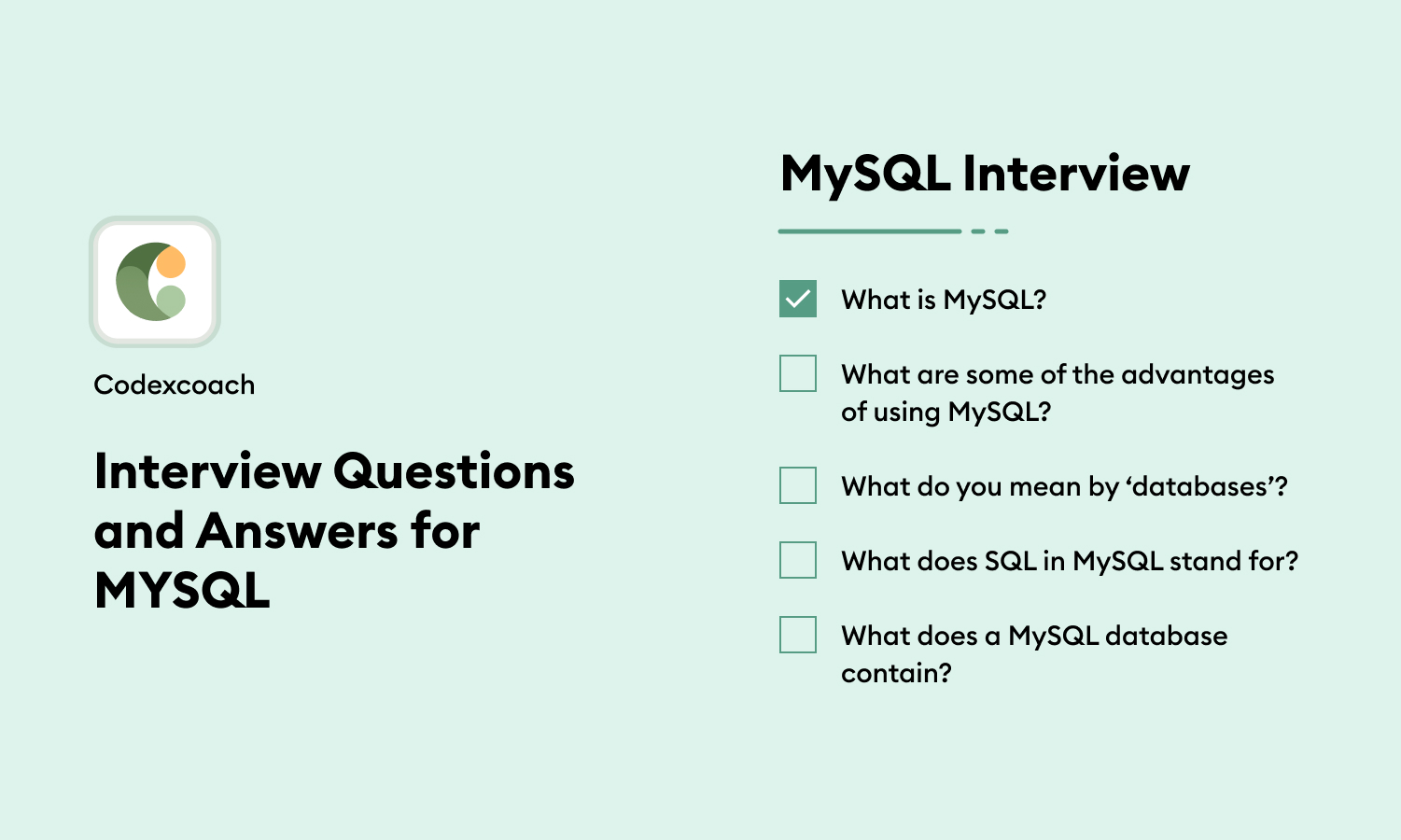If you’re getting ready for a MySQL interview, it’s a good idea to go over the basics and more tricky parts of this popular database system. You might get asked to write simple SQL commands or to tackle tougher problems about how to make databases work better and faster. This guide is packed with typical questions you might hear in a MySQL interview, along with clear answers to show off what you know.
What is MySQL?
MySQL is an open-source relational database management system (RDBMS) based on Structured Query Language (SQL). It is widely used for web applications and acts as the database component of the LAMP, MAMP, and WAMP platforms (Linux/Mac/Windows, Apache, MySQL, PHP/Perl/Python).
Can you explain the difference between a primary key and a unique key?
Both primary and unique keys are used to ensure the uniqueness of a column or a set of columns. A primary key creates a unique identifier for each record in the table and does not allow NULL values. On the other hand, a unique key also ensures that a column or group of columns is unique but can accept a single NULL value.
What is a join in MySQL? Can you explain the different types of joins?
A join is an SQL operation used to combine rows from two or more tables based on a related column between them. There are several types of joins:
- INNER JOIN: Returns rows when there is a match in both tables.
- LEFT JOIN (or LEFT OUTER JOIN): Returns all rows from the left table, and the matched rows from the right table; the result is NULL from the right side if there is no match.
- RIGHT JOIN (or RIGHT OUTER JOIN): Returns all rows from the right table, and the matched rows from the left table; the result is NULL from the left side if there is no match.
- FULL JOIN (or FULL OUTER JOIN): Returns rows when there is a match in one of the tables.
- CROSS JOIN: Returns all records where each row from the first table is combined with each row from the second table.
- SELF JOIN: A regular join, but the table is joined with itself.
How do you create an index in MySQL and what are its types?
An index in MySQL is created using the CREATE INDEX command. The basic syntax is: CREATE INDEX index_name ON table_name (column1, column2, …). The different types of indexes in MySQL include:
- Primary Key Index: Enforces uniqueness and cannot contain NULL values.
- Unique Index: Enforces uniqueness for the column or columns.
- Index: The standard index to improve the queries’ performance.
- Full-text Index: Used for full-text searches.
- Composite Index: An index on two or more columns of a table.
What are stored procedures in MySQL and how do they differ from functions?
Stored procedures are a set of SQL statements that can be stored in the database server and executed as a unit. They are useful for repetitive tasks, can reduce network traffic, and can provide improved security controls. Functions are also a set of SQL statements, but they always return a value and can be used in SQL statements wherever an expression is allowed.
Explain the difference between CHAR and VARCHAR data types in MySQL.
CHAR is a fixed-length string data type, which means that it always reserves space for the specified number of characters. If the string stored is shorter than the specified length, it will be padded with spaces. VARCHAR is a variable-length string data type, meaning it only uses as much space as the string stored plus an additional one or two bytes to record the length of the string.
What is a transaction and what are ACID properties?
A transaction is a logical unit of work that comprises one or more SQL statements executed by a single user. In MySQL, the InnoDB storage engine supports transactions. ACID stands for Atomicity, Consistency, Isolation, and Durability:
- Atomicity: Ensures that all operations within the work unit are completed successfully; otherwise, the transaction is aborted.
- Consistency: Ensures that the database properly changes states upon a successfully committed transaction.
- Isolation: Enables transactions to operate independently of and transparent to each other.
- Durability: Ensures that the result or effect of a committed transaction persists in case of a system failure.
How do you optimize a MySQL query?
To optimize a MySQL query, one could:
- Use proper indexes.
- Avoid using wildcards at the start of a LIKE pattern.
- Use the EXPLAIN statement to understand how MySQL executes a query.
- Choose the appropriate storage engine for the database’s requirements.
- Limit the use of heavy-duty functions or subqueries.
- Optimize joins to reduce the number of rows that need to be processed.
What is normalization? Can you explain the different normal forms?
Normalization is the process of organizing data in a database to avoid duplication and redundancy. Several normal forms are used to progressively reduce redundancy and dependency:
- First Normal Form (1NF): Eliminates duplicate columns from the same table and creates separate tables for each group of related data.
- Second Normal Form (2NF): Removes subsets of data that apply to multiple rows of a table and places them in separate tables.
- Third Normal Form (3NF): Eliminates fields that do not have a dependency on the primary key.
- Boyce-Codd Normal Form (BCNF): Addresses anomalies not handled by 3NF.
- Fourth (4NF) and Fifth Normal Forms (5NF): Address multi-valued dependencies and join dependencies, respectively.
What are the different storage engines used in MySQL?
MySQL supports several storage engines that handle different table types. The most commonly used are:
- InnoDB: Supports transactions, row-level locking, and foreign keys.
- MyISAM: Prioritizes speed over support for transactions.
- Memory: Stores all data in RAM for fast access but is non-durable.
- CSV: Stores data in a comma-separated values file.
- Archive: Optimized for storing large amounts of data without indexes.
What are foreign keys, and how are they used in MySQL?
Foreign keys are used to link two tables together. They are a field (or collection of fields) in one table that uniquely identifies a row of another table. The table containing the foreign key is called the child table, and the table containing the candidate key is called the referenced or parent table.
What is a trigger in MySQL?
A trigger is a database object that is directly associated with a table and is activated when a particular event occurs for that table, such as INSERT, UPDATE, or DELETE operations.
How can you prevent SQL injections in MySQL?
To prevent SQL injections, you can:
- Use prepared statements and parameterized queries.
- Avoid using dynamic SQL.
- Validate user input for type, length, format, and range.
- Employ stored procedures.
- Limit database permissions and provide the least privileges necessary for the application.
What is a view in MySQL?
A view is a virtual table that consists of a subset of data contained in one or more tables. Views are not stored physically on disk; instead, they are derived from tables and are used to simplify complex queries, provide data encapsulation, and ensure data security.
What are the MyISAM and InnoDB storage engines? How do they differ?
MyISAM and InnoDB are two of the most common MySQL storage engines:
- MyISAM: Optimized for environments with heavy read operations, but does not support transactions or foreign keys, and it utilizes table-level locking.
- InnoDB: Supports transactions, and foreign keys, and uses row-level locking, making it suitable for environments with heavy write operations.
What is a covering index in MySQL?
A covering index is an index that contains all and only the fields required by a query. When a query can be satisfied entirely by the index itself, it’s said to be “covered.”
How can you improve the performance of a MySQL SELECT query?
To improve the performance of a SELECT query:
- Use indexes wisely to help the database engine to fetch data faster.
- Select only the necessary columns rather than using SELECT *.
- Make use of the query cache.
- Use the LIMIT clause when retrieving data from a large table.
- Avoid complex joins when possible and optimize join conditions.
- Use the proper WHERE clause to filter out unnecessary records.
What is a deadlock and how can it be avoided in MySQL?
A deadlock occurs when two or more transactions are waiting for each other to release locks. MySQL automatically detects and resolves deadlocks by rolling back one of the transactions. To avoid deadlocks:
- Keep transactions as short as possible.
- Access tables in a consistent order.
- Avoid unnecessary locking if possible.
- Use indexing to speed up queries, reducing the time locks are held.
Explain the differences between DELETE, TRUNCATE, and DROP commands in MySQL.
- DELETE: Removes rows from a table based on a WHERE condition; it is a DML command and can be rolled back.
- TRUNCATE: Removes all rows from a table, resetting the table’s auto-increment counter; it is a DDL command and cannot be rolled back.
- DROP: Deletes the entire table and its structure; the operation cannot be rolled back.
What is replication in MySQL?
Replication in MySQL is the process of copying data from one database server (the master) to one or more database servers (the slaves). It is used for scaling out, data backup, and ensuring data security.
What are the different types of replication in MySQL?
There are primarily three types of replication in MySQL:
- Asynchronous Replication: The master writes events to the binary log and does not wait for the slaves to acknowledge the receipt. This is the most common replication method.
- Semi-synchronous Replication: The master waits for at least one slave to acknowledge the receipt of the event before considering the write operation complete.
- Synchronous Replication: Transactions are committed only when all nodes are synchronized at a certain point (not commonly used in standard MySQL, more associated with MySQL Cluster).
What is the difference between float, double, and decimal data types in MySQL?
- Float: A floating-point number that cannot guarantee precision, typically used for scientific calculations.
- Double: A double-precision floating-point number that is also subject to rounding errors but has more precision than a float.
- Decimal: A fixed-point number that is exact and is used when it is important to preserve exact precision, such as for financial data.
How does MySQL use indexes to improve query performance?
MySQL uses indexes to find rows with specific column values quickly without having to look at every row in a table. This is akin to an index in a book, which allows you to find the information quickly without reading every page.
Explain the LIKE clause in MySQL.
The LIKE clause is used in a WHERE statement to search for a specified pattern in a column. There are two wildcards often used in conjunction with the LIKE operator: %, which allows for any number of characters to be in its place, and _, which allows for a single character.
What is the difference between GROUP BY and ORDER BY in MySQL?
- GROUP BY: This statement is used with aggregate functions like COUNT, MAX, MIN, SUM, and AVG to group the result set by one or more columns.
- ORDER BY: This statement is used to sort the result set in ascending or descending order.
Explain the HAVING clause in MySQL.
The HAVING clause is used to filter records that work on summarized GROUP BY results. It is different from the WHERE clause in that it can filter aggregated data, whereas the WHERE clause cannot.
How can you copy data from one table to another in MySQL?
You can copy data from one table to another using the INSERT INTO … SELECT statement. This statement copies data from one table and inserts it into another. The tables must have a similar structure.
What is the BETWEEN operator in MySQL?
The BETWEEN operator is used to select values within a given range. The values can be numbers, text, or dates. It is inclusive: begin and end values are included.
What are the TIMESTAMP data types and their range in MySQL?
The TIMESTAMP data type is used to store a combination of date and time. The range for a TIMESTAMP in MySQL is ‘1970-01-01 00:00:01’ UTC to ‘2038-01-19 03:14:07’ UTC.
Can you explain subqueries in MySQL? What are the types of subqueries?
A subquery, also known as an inner query or nested query, is a query within another MySQL query and enclosed within parentheses. There are two types of subqueries: correlated and non-correlated.
- Non-correlated subquery: This subquery is an independent query where the inner query is executed first and its result is passed to the outer query.
- Correlated subquery: This subquery depends on the outer query for its value, which means that the inner query is executed repeatedly, once for each row processed by the outer query.
What is VARCHAR and how is it different from TEXT in MySQL?
Both are variable-length data types used to store character strings. The key differences are:
- VARCHAR is used for strings that vary in length, but typically have a known, limited length. It can hold a maximum of 65,535 characters.
- TEXT is used for large strings that can hold up to 65,535 characters. When full width is not used, it consumes more space than VARCHAR.
How can you create a temporary table in MySQL? When is it useful?
A temporary table can be created using the CREATE TEMPORARY TABLE syntax. It is useful for storing immediate results that you need to use more than once in subsequent queries within the same session.
What is the ENUM type used for in MySQL?
The ENUM type is used to represent a string object from a predefined list of values. It is a static set that can list up to 65,535 distinct elements.
What is the SHOW STATUS command used for?
The SHOW STATUS command provides information about server status variables. It can be used to monitor MySQL server activity and performance.
Explain the concept of ‘views’ in MySQL and how they are different from tables.
A view is essentially a virtual table that is used to represent the results of a stored query. Unlike tables, views do not store data persistently and when the data in the underlying tables change, the data returned by views also change.
How does the UNION operator work in MySQL?
The UNION operator is used to combine the result sets of two or more SELECT statements. It removes duplicate rows between the various SELECT statements. Each SELECT statement within the UNION must have the same number of columns, and the columns must have similar data types.
What is SQL Injection and how can you prevent it in MySQL?
SQL Injection is a code injection technique where an attacker can insert malicious SQL statements into an entry field for execution. To prevent it, one should use parameterized queries or prepared statements instead of string concatenation within the queries.
What is the use of the LIMIT clause?
The LIMIT clause is used to constrain the number of rows returned by a query. It is often used in pagination where you can specify the number of records to be retrieved and the starting point for the record retrieval.
Can you explain the difference between the HAVING and WHERE clauses?
The WHERE clause is used to filter rows before the grouping operation, whereas the HAVING clause is used to filter groups after the grouping operation.
Wrapping up, acing a MySQL interview requires a solid grasp of database fundamentals, practical SQL skills, and the ability to solve complex data problems. With the questions and answers covered, you should feel more confident about handling a range of topics from basic query syntax to intricate database operations. Remember, practice makes perfect. So, keep experimenting with real-world scenarios, and you’ll be well-prepared to impress your interviewers with your MySQL knowledge.





